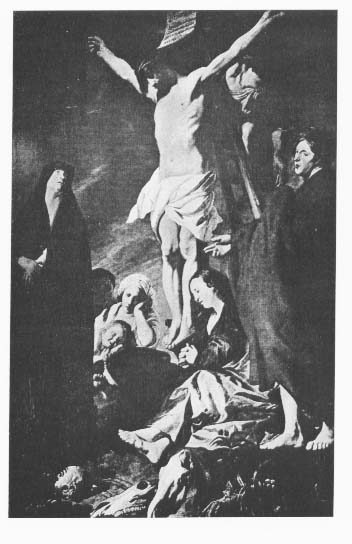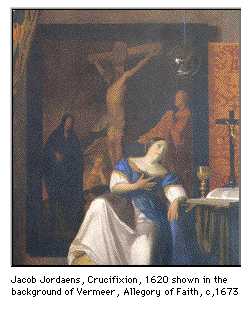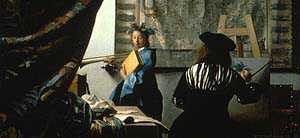 Jacob
Jordaens, Crucifixion, c. 1620.
Jacob
Jordaens, Crucifixion, c. 1620.  Jacob
Jordaens, Crucifixion, c. 1620.
Jacob
Jordaens, Crucifixion, c. 1620.
A large painting showing Christ on the Cross, 'Een groote schildery uitbeeldende Christus aent cruys', In the inner kitchen, room C
or
A painting showing Christ on the Cross, 'Een schildery uytbeeldende Christus aen't Cruys', above the cellar room, room B.
One of these two paintings, probably the first one mentioned above, is shown by Vermeer in the background of his painting 'Allegory of Faith'. The original painting is that by Jacob Jordaens, Crucifixion, c. 1620, now in a private collection, Terningh collection, Antwerp. Vermeer may have owned a simplified and smaller copy.
It is quite remarkable that this painting was not exhibited in the Great Hall 'Groote zael', room I, but in the much smaller inner kitchen 'binnekeucken'. In this room also hung the gold tooled-leather, also shown in the 'Allegory of Faith.
 The
painting 'Allegory of Faith' by Vermeer has been judged by critics as
his only artistic mistake. Painted in a high finish illusionism, both
the snake and the pathetic gesture are far removed from a believable
scene in a Dutch interior. This painting was possibly ordered by
circles of Delft Jesuits, who wanted a picture just as spectacular as
'The Artist in his Studio', now in Vienna.
The
painting 'Allegory of Faith' by Vermeer has been judged by critics as
his only artistic mistake. Painted in a high finish illusionism, both
the snake and the pathetic gesture are far removed from a believable
scene in a Dutch interior. This painting was possibly ordered by
circles of Delft Jesuits, who wanted a picture just as spectacular as
'The Artist in his Studio', now in Vienna.
Note : This object was part of the Vermeer-inventory as listed by the clerk working for Delft notary public J. van Veen. He made this list on February 29, 1676, in the Thins/Vermeer home located on Oude Langendijk on the corner of Molenpoort. The painter Johannes Vermeer had died there at the end of December 1675. His widow Catherina and their eleven children still lived there with her mother Maria Thins.
The transcription of the 1676 inventory, now in the Delft archives, is based upon its first full publication by A.J.J.M. van Peer, "Drie collecties...", Oud Holland, 1957, pp. 98-103. My additions and explanations are added in square brackets [__]. Dutch terms have been checked against the world's largest language dictionary, the Dictionary of the Dutch Language (Woordenboek der Nederlandsche Taal , or WNT), which was begun by De Vries en Te Winkel in 1882.
 Image
above: detail of "Allegory of Faith' c. 1671-1674 by Vermeer, in the
Metropolitan Museum of Art, New York City.
Image
above: detail of "Allegory of Faith' c. 1671-1674 by Vermeer, in the
Metropolitan Museum of Art, New York City.
Image left detail of the 'Artist in his Studio', Kunsthistorisches Museum, Vienna.
Montias 1989, 189 discusses differences between the Terningh painting and the one shown by Vermeer.
This page forms part of a large encyclopedic site on Vermeer and Delft. Research by Drs. Kees Kaldenbach (email). A full presentation is on view at johannesvermeer.info.
Launched December, 2002; Last update March 2, 2017.
Back to the Welcome page: click Welcome.